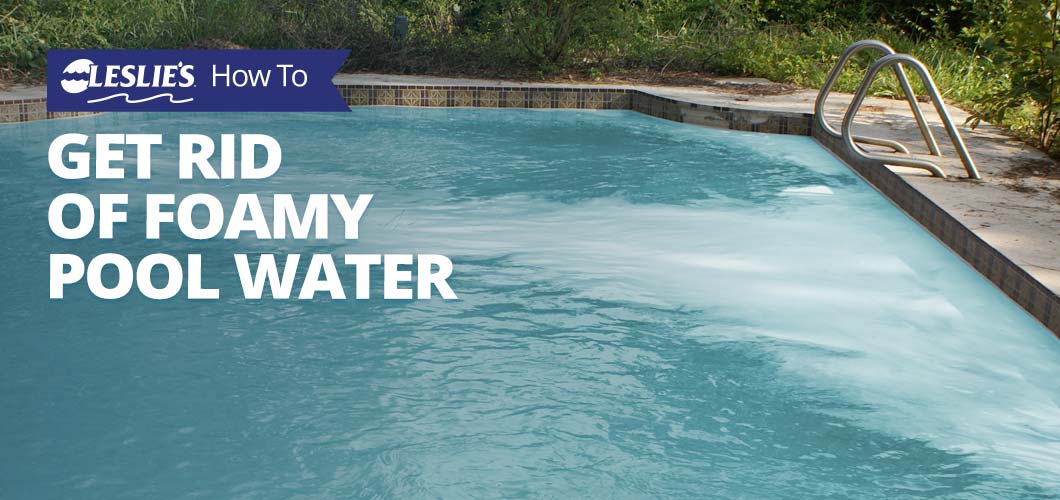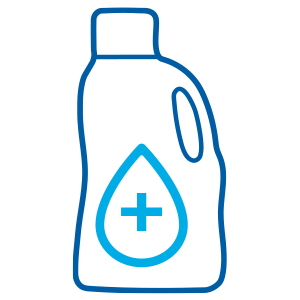
How to Get Rid of Foamy Pool Water
Imagine this: you walk outside and head to your pool, ready to dive in. However, you notice your pool looks different today. There is a layer of white foam (or bubbles) forming on the surface of the water. While a foamy pool might look fun — like a bubble bath — it's actually a cause for concern. But don’t fret. Foamy pool water isn't dangerous; it just makes your pool look unclean, and it's a bit uncomfortable to swim in. Of course, the best way to get rid of foam in a swimming pool is by preventing it from happening in the first place. But if you're currently dealing with foamy pool water, there are several ways to remedy this pesky inconvenience.
What is Pool Foam?
Foam can look like bubbles in your pool, making you think that it’s just made up of air. But this is incorrect. Foam in your pool means there is a high amount of organic material in the water. The organic material causes the water to be oversaturated, which makes it difficult for the material to dissolve. This results in “thick,” cloudy-looking water. Sounds gross, right? Not exactly the look or feel you want in your pool.
Why is My Swimming Pool Foamy?
What causes pool foam? When you notice that your pool is foamy, it's most often caused by one of the following issues:

1. Swimming Without Showering
One of the most common reasons for a foamy pool is swimmers entering the water without showering first. The human body is covered in residue from a variety of things, including shampoo, deodorant, lotions, and laundry detergent.
Showering with your suit on prior to swimming helps remove excess oils, shampoos, makeup, laundry residue, and any other contaminants, which can mix with the chemicals in your pool and cause foam. We know this might be a weird, slightly awkward request coming from a pool owner, but asking swimmers to rinse off beforehand will help eliminate future pool problems.
2. Poor Water Balance

If your water isn't properly balanced, your sanitizer can't work efficiently. And if your sanitizer can't work efficiently, the organic contaminants in your pool will build up and create a foaming problem. Total Alkalinity affects pH, and pH impacts sanitizer efficiency, so they should be among the first things you check during routine water testing.
Low Calcium Hardness levels can also play a role in pool water foaming, especially if levels are too low. When Calcium Hardness levels are below the ideal range, that means your pool has soft water. Not only can this cause damage to pool surfaces over time, but it can also increase the water's ability to foam up.
Learn more about proper water balance in our online guide, Pool Chemistry 101. To keep it simple, make sure these aspects of water chemistry are in balance to prevent foamy pool water:
- Total Alkalinity: 80–120 ppm
- pH: 7.4–7.6
- Calcium Hardness: 200–400 ppm
- Cyanuric Acid: 30–50 ppm
- Chlorine: 2.0–4.0 ppm
- Total Dissolved Solids: 0–2500 ppm for non-saltwater pools.

3. Using the Wrong Algaecide
Saving money where you can is a no-brainer. But when it comes to pool maintenance, the cheaper option is not always the best choice for your pool. For example, low-quality algaecides can lead to a foamy pool. We recommend only using high-quality chemicals in your pool to prevent issues later.
Always follow the suggested dosing instructions for your algaecide, as using too much can also cause foaming.
The silver lining for this issue is that pool foam caused by algaecide usually breaks down on its own, so it's just a waiting game for the foam to disappear. You can always skim your pool’s surface if you want to speed up the process.
4. There's an Air Leak in Your System

If your swimmers are freshly showered and your pool water chemistry is pristine, but you still have a foamy pool, there may be a technical problem at hand. While a foamy pool typically has a chemical cause, large amounts of bubbles from an air leak in your pool pump or suction line can give your pool’s surface a similar frothy appearance.
An air leak in your pump system prevents the pump from running at full speed and inhibits water circulation. One reason for an air leak is a low pool water level. A quick way to check that your pool is at the right level is to look at your pool skimmer. If the skimmer is less than halfway submerged, the pool level is too low. Add more water to your pool to raise the level and prevent the skimmer from sucking excess air into the pump.
If the pool water level isn't the problem, then it might be time to look at the components of your pool pump system. Two common culprits are that the strainer pot lid or the pump/valve union are not secured tightly. If you’re not familiar with the inner workings of your pump, we recommend that you have a professional investigate this further.
How to Remove Pool Foam
There is no single way to fix a foamy pool. Your method for getting rid of pool foam depends on the cause.

When high levels of organic contaminants are to blame, shock the pool. Superchlorinating the water with a quality pool shock will help break down foam-causing contaminants like cosmetics, hair care products, deodorant, body oils, and so much more. If foamy water is a chronic issue in your pool, you might also consider weekly enzyme treatments to break down organic debris and help your sanitizer work most efficiently.
Checking the balance of your pool’s chemistry level with an at-home testing kit is also key in stopping pool foam. A well balanced pool means your sanitizer can work effectively and keep organics under control.
If low-quality or excessive amounts of algaecide caused the foamy pool, simply give the product time to absorb into the water. You can also skim the foam off the pool surface to speed things up.
Preventative Measures to Avoid a Foamy Pool
While it’s frustrating dealing with a foamy pool, the great thing is that there are preventative measures you can take to avoid having this issue altogether!
First things first: always shower before swimming. Taking a few minutes to rinse off prior to jumping in the water will prevent unnecessary product buildup in your pool. Second, routinely check water balance, and shock the pool weekly to break down foam-causing organics and maintain healthy water. Third, purchase high-quality algaecide and follow the dosing instructions on the bottle. And finally, look out for air leaks. Maintaining a proper water level and fixing any loose or broken pump parts will prevent excess air from entering your system in the first place.
While foam might make your pool look like a giant bubble bath, and it might be seen as a kind of party trick when you have guests over, it's a sign of underlying issues that need to be resolved. Take solace in the fact that a foamy pool is one of the less serious problems a pool owner can have. Following the proper steps to fix it will result in a foam-free pool in no time!
If you have any questions about pool foam issues, Leslie's can help! Stop by your local Leslie's to speak with one of our professionals about how to manage your foamy pool.